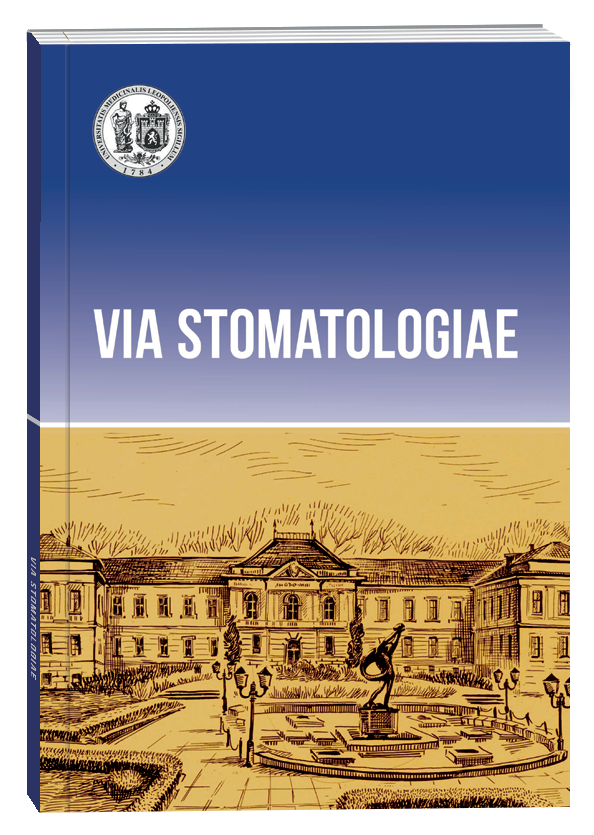ВИКОРИСТАННЯ ПОКАЗНИКІВ ДЕНСИТОМЕТРІЇ КІСТКОВОЇ ТКАНИНИ ДЛЯ ОПТИМІЗАЦІЇ ДІАГНОСТИКИ ТА ЛІКУВАННЯ ДІТЕЙ У СТОМАТОЛОГА
DOI:
https://doi.org/10.32782/3041-1394.2024-1.7Ключові слова:
діти, денситометрія, мінеральна щільність кісткової тканини, патологія зубощелепної системиАнотація
Мета дослідження – оцінка показників денситометрії як додаткового методу дослідження у стоматології з метою виявлення змін активності процесів трансформації кісткових структур організму дитини та впровадження отриманих результатів у протокол обстеження пацієнтів дитячого віку. Методи дослідження. Обстежено 108 дітей (65 хлопчиків та 43 дівчаток) віком 6–13 років м. Львова та Львівської області, які проходили стоматологічне лікування чи консультацію на момент дослідження. Ультразвукова денситометрія п’яткової кістки дітей проводилась за допомогою ультразвукового кісткового денситометра «Achilles» фірми LUNAR Corp. (США), що вимірює швидкість поширення ультразвукової хвилі по кістковій тканині. Після отримання даних денситометрії проведено математичний та статистичний аналіз, а також оцінку кореляції отриманих даних із рентгеноморфометричними показниками індексів нижньої щелепи визначених по ортопантомограмах даної вибірки дітей. Наукова новизна. Пошук високоінформативних і безпечних методів оцінки стану кісткової тканини залишається актуальним напрямком досліджень у сучасній стоматології. Визначення стану кісткової тканини дитини має важливе значення в діагностиці, профілактиці та лікуванні патологій зубощелепової системи. Під час складання плану як ортодонтичного, так і хірургічного лікування патологічних змін у кістковій тканині зубощелепної системи враховують такі критерії: вік пацієнта, супутні соматичні захворювання, локалізацію патологічного процесу та стан кісткової тканини. Висновки. Впровадження методу ультразвукової денситометрії п’яткової кістки як додаткового методу обстеження у дитячій стоматології та ортодонтії є безпечним методом діагностики змін щільності кісткової тканини, а результати, отримані за допомогою цього метода обстеження, сумісні з рекомендаціями ВООЗ. Таким чином, цей метод може широко застосовуватися при обстеженні пацієнтів з ортодонтичною патологією з метою визначення фактору ризику – зниження щільності кісткової тканини.
Посилання
Santoro V, Roca R, De Donno A, Fiandaca C, Pinto G, Tafuri S, et al. Applicability of Greulich and Pyle and Demirijan aging methods to a sample of Italian population. Forensic Sci Int 2012;221:153. e1-5.
Schmeling A. Age estimation of unaccompanied minors. Part I. General considerations. J. Forensic Sci. № 159(Suppl). 2006. Р. 61–64.
Schmeling A, Grundmann C, Fuhrmann A еt al. Criteria for age estimation in living individuals. Int. J. Legal Med. № 122(6). 2008. Р. 457–460.
Muñoz-Calvo MT, Argente J. Nutritional and Puberal Disorders. Endocr Dev. 2016;29:153–73.
Crawford B, Kim DG, Moon ES, Johnson E, Fields HW, Palomo JM, et al. Cervical vertebral bone mineral density changes in adolescents during orthodontic treatment. Am J Orthod Dentofacial Orthop. 2014;146:183–9.
Moon E-S, Kim S, Kim N, Jang M, Deguchi T, Zheng F, Lee DJ, Kim D-G. Aging Alter Cervical Vertebral Bone Density Distribution: A Cross-Sectional Study.Applied Sciences. 2022; 12(6):3143. doi.org/10.3390/app12063143.
Рашид Э. Мамедзаде. Моніторинг динаміки лікування зуба з периапікальною деструкцією кісткової тканини за показниками оптичної денситометрії. Сучасна стоматологія, (1) 2016. С. 18–20.
Криницький РП. Особливості вікової динаміки щільності кісткової тканини нижньої щелепи у осіб чоловічої та жіночої статі. Актуальні питання медичної науки та практики. 2015. т. 2(82), 1. С. 71–79.
Ryzhuk R, Dahno L, Chaykovska S, Pavliv K. Peculiaritiesof structural reconstruction and mineral content dynamic of hardtissues of dentomandibular area in age aspect. The 5th International Symposium of Clinical and Applied Anatomy. Book of Abstacts. 2013. 5(2):140.
Івашенко СВ. Оптимізація активного періода ортодонтичного лікування зубощелепних аномалій і деформацій. Медичний журнал. 2014. (2):129–132.
Dvorak G, Arnhart C, Heuberer S [et al.]. Peri-implantitis and late implant failures in postmenopausal women: a cross-sectional study. J. Clin. Periodontol. 2011. Vol. 38(10):950–955.
Масна ЗЗ., Павлів К, Чайковська С. Закономірності вікової перебудови коміркової частини нижньої щелепи в онтогенезі. ХII з’їзд ВУЛТ. Kиїв; 2013:302-3.
Чайковська С., Масна З.З., Павлів К.Ю., Масна-Чала О.З. Аналіз частоти зустрічання патологічних форм прикусу, пов’язаних з ростом і розвитком нижньої щелепи у підлітків з різними конституційними типами будови черепа. Сучасні аспекти реабілітації в медицині : матеріали VII міжнародної конференції. Єреван, 2015, 16–18 вересня. Єреван, 2015. С. 294–296.
Криницький РП, Дахно ЛО, Масна ЗЗ, Рижук ХА, Кухлевський Ю. Порівняльний аналіз стану кісткової тканини коміркових ділянок верхньої та нижньої щелеп у осіб зрілого віку за умови збереження зубних рядів, при адентії та після дентальної імплантації. Стоматологічні новини. Актуальні питання стоматології : матеріали міжнародної науково-практичної конференції, м. Львів, 28–29 жовтня 2015 р. Львів. С. 38–39.
Jagelaviciene E, Kubilius R, Krasauskiene A. The relationship between panoramic radiomorphometric indices of the mandible and calcaneus bone mineral density. Medicina (Kaunas). 2010. Vol. 46 (2). P. 95–103.
Dutra V, Yang J, Devlin H, Susin Ch. Radiomorphometric indices and their relation to gender, age, and dental status. Oral Surg Oral Med Oral Pathol Oral RadiolEndod. 2005. Vol. 99(4). P. 479–484.
Coe J. Speeding up assessment of bone mineral density. Practice Nursing. 2008. Vol. 19(4). P. 177–180.
Gordon CM, LeonardMB, Zemel BS; International Society for Clinical Densitometry. 2013 Pediatric Position Development Conference: executive summary and reflections. J Clin Densitom. 2014;17(2):219–224.
Crabtree NJ, Arabi A, Bachrach LK, et al;International Society for Clinical Densitometry. Dual energy X-ray absorptiometry interpretation an dreportindren and adolescents: the revised 2013 ISCD Pediatric Official Positions. J Clin Densitom. 2014;17(2):225–242.
Bishop N, Arundel P, Clark E, et al; International Society of Clinical Densitometry.Fracture prediction and the definition of osteoporosis in children and adolescents: the ISCD 2013 pediatric official positions. J Clin Densitom. 2014;17(2):275–280.
Барна ОМ, Головач ІЮ, Погребняк ОО, Корост ЯВ, Пехенько ВС, Аліфер ОО, Лотушко ВВ. Оцінка стану кісткової тканини за показниками УЗ денситометрії у віковому аспекті. Ліки України. Medicine of Ukraine. 2017;8(214):66–67.
Lakhtin YV, Zviahin SM, Karpez LM. The State of The Optical Density of The Alveolar Process of The Jaws of Rats in Supraocclusive Relationships of Individual Teeth in The Age Aspect. Wiad Lek. 2021;74(8):1800–1803.
Kazuhiko Nakata, Masahiro Izumi, Munetaka Naitoh, Kyoko Inamoto. Effectiveness of Dental Computed Tomography in Diagnostic Imaging of Periradicular Lesion of Each Root of a Multirooted Tooth: A Case Report July 2006 Journal of Endodontics 32(6):583–587.
Поворознюк ВВ, Григор’єва НВ, Поворознюк ВВ. Ультразвукова денситометрія в оцінці структурно-функціонального стану кісткової тканини. Біль. Суглоби. Хребет. 2013;4(12):5–12.
Devlin H, Horner K. Mandibular radiomorphometric indices in the diagnosis of reduced skeletal bone mineral density. Osteopor Int. 2002. Vol. 13. P. 373–378.
Оснач РГ, Лисенко ОС, Паливода ІІ. Рентгенологічна денситометрія щелеп при оцінці швидкості ортодонтичного переміщення зубів. Сучасна стоматологія. 2015(4):120–124.
Pavicin IS, Ivosević-Magdalenić N, Badel T et al. Analysis of dental supportive structures in orthodontic therapy. Coll Antropol. 2012. Vol. 36, N3. P. 779–783.
Campos MJ, de Albuquerque EG, Pinto BC et al. The role of orthodontic tooth movement in bone and root mineral density: a study of patients submitted and not submitted to orthodontic treatment. Med. Sci Monit. 2012. Vol. 18, N 12. P. 752–757.
Kalkwarf HJ, Abrams SA, Di Meglio LA, Koo WW, Specker BL, Weiler H;International Society for Clinial Densitometry. Bone densitometry ininfants and young children: the 2013 ISCD pediatric official positions. J Clin Densitom. 2014;17(2):243–257.
Judith E. Adams. Bone Densitometry in Children. Semin Musculoskelet Radiol, 2016; 20(03): 254-268. DOI: 10.1055/s-0036-1592369.
Khalatbari, H., Binkovitz, L.A. & Parisi, M.T. Dual-energy X-ray absorptiometry bone densitometry in pediatrics: a practical review and update.Pediatr Radiol. 2021; 51:25–39. https://doi.org/10.1007/s00247-020-04756-4.
Марушко Ю.В., Волоха Т.І., Асонов А.О. Ультразвукова денситометрія (аксіальне вимірювання) у діагностиці остеопенічного синдрому у дітей з різною соматичною патологією. Сучасна педіатрія. 2016.1(73):54–58.
Макєєв В.Ф., Ісакова О.О. Оцінка динаміки рентгеноморфометричних індексів щелеп у дітей у період змінного прикусу. Сучасна стоматологія. 2021;2 (106):68–74. DOI: 10.33295/1992-576X-2021-2-68.
Ісакова О.О., Макєєв В.Ф. Оцінка стану кісткової тканини в протоколі обстеження пацієнтів дитячого лікаря-стоматолога. Science and practice, аctual problems, innovaitions : матеріали XVIII Міжнародної науково-практичної конференції, м. Мілан, Італія, 19–22 липня 2022 р. С. 134–137.







